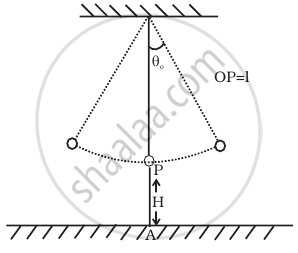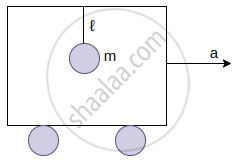Advertisements
Advertisements
Question
A body of mass m is situated in a potential field U(x) = U0 (1 – cos αx) when U0 and α are constants. Find the time period of small oscillations.
Solution
Given the potential energy associated with the field
U(x) = U0 (1 – cos αx) [∵ For conservative force f, we can write f =
Now, Force F =
F =
F =
⇒ F ∝ (– x)
As, U0, a being constant.
∴ Motion is S.H.M for small oscillations.
The standard equation for S.H.M F =
Comparing equations (ii) and (iii), we get
∴ Time period T =
APPEARS IN
RELATED QUESTIONS
Answer the following questions:
A man with a wristwatch on his hand falls from the top of a tower. Does the watch give correct time during the free fall?
The cylindrical piece of the cork of density of base area A and height h floats in a liquid of density
where ρ is the density of cork. (Ignore damping due to viscosity of the liquid).
Show that motion of bob of the pendulum with small amplitude is linear S.H.M. Hence obtain an expression for its period. What are the factors on which its period depends?
A simple pendulum has a time period of T1 when on the earth's surface and T2 when taken to a height R above the earth's surface, where R is the radius of the earth. The value of
If the maximum velocity and acceleration of a particle executing SHM are equal in magnitude, the time period will be ______.
A cylindrical log of wood of height h and area of cross-section A floats in water. It is pressed and then released. Show that the log would execute S.H.M. with a time period.
A tunnel is dug through the centre of the Earth. Show that a body of mass ‘m’ when dropped from rest from one end of the tunnel will execute simple harmonic motion.
A simple pendulum of time period 1s and length l is hung from a fixed support at O, such that the bob is at a distance H vertically above A on the ground (Figure). The amplitude is θ0. The string snaps at θ = θ0/2. Find the time taken by the bob to hit the ground. Also find distance from A where bob hits the ground. Assume θo to be small so that sin θo = θo and cos θo = 1.

A pendulum of mass m and length ℓ is suspended from the ceiling of a trolley which has a constant acceleration a in the horizontal direction as shown in the figure. Work done by the tension is ______.
(In the frame of the trolley)

A particle at the end of a spring executes simple harmonic motion with a period t1, while the corresponding period for another spring is t2. If the period of oscillation with the two springs in series is T, then ______.
